
Getting ‘unstuck’ from a bog hole, sand trap or from being bellied out in the rocks is an art.
Sure, winches are great, but there are times when they can’t be used. That’s where traction aids (sand tracks, bog mats, traction ladders, bridging ladders, or whatever you want to call them) can come in handy.
Basically, once a 4x4 becomes stuck, shoving something under the wheels to give them traction is how these devices work; you’re introducing a firmer surface for your 4x4 to drive on to (hopefully) free yourself.
We recently rounded up all the various types of traction aids on the market and hit the sand to see how each performed. We filmed each to show exactly how they work, so head on over to the Recovery boards beach test to see the action.
Some aids are great in just sand, some benefit in the rocks, while others can be used as bridging ladders. Some can be easily stored under your vehicle’s seats, while others (due to their physical size) are relegated to the roof racks for storage. To take it further, some of these aids can double as tent door mats, whereas others would be downright uncomfortable to stand on and would cause pain if used as an impromptu seat – you’ve been warned!
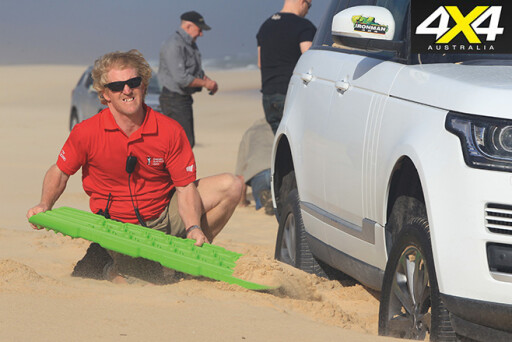 One piece of equipment that should be carried and used prior to any of these traction aids (on sand) is the shovel. A bit of hard work prior to any attempt at driving out of the bog will help the situation, so start digging first. A point to note about all these products is that you should avoid wheel spin while trying to drive up/on/over them. Doing so will damage some of the products and/or render them a little useless. So, low range and a gentle throttle is the go.
One piece of equipment that should be carried and used prior to any of these traction aids (on sand) is the shovel. A bit of hard work prior to any attempt at driving out of the bog will help the situation, so start digging first. A point to note about all these products is that you should avoid wheel spin while trying to drive up/on/over them. Doing so will damage some of the products and/or render them a little useless. So, low range and a gentle throttle is the go.
With a little hard work, a cool head and a light right boot, you should be able to extract yourself from most boggings by yourself.
Oh, and one last tip – tie a length of rope or a strap to the end of each track to help find and remove them from the sand, water, mud or snow. If you can’t pull it out by hand, use your 4x4 to pull them out and save yourself from the hard work of digging them up.
THE METHOD
We undertook considerable effort to ensure the Land Cruiser was bogged and placed in a similar position for each recovery device, plus we always used first-gear low range to idle onto or up each device to minimise wheel spin and momentum. This was to help show which device delivered superior traction to allow self recovery with a minimum of fuss. Any slight variances experienced would make bugger-all difference in real-life recovery situations.
We set the whole show up on a soft uphill track that exits the main beach, which is often the most difficult place to drive. Tyre pressures were set at 20psi, front and rear lockers were engaged to provide constant drive to all wheels. This gave the tyres the best chance of gripping the boards. We also ensured the Cruiser was bogged to a similar depth each time, checking that the diffs and chassis rails were not bottomed out. All up, everything was fair and equal.
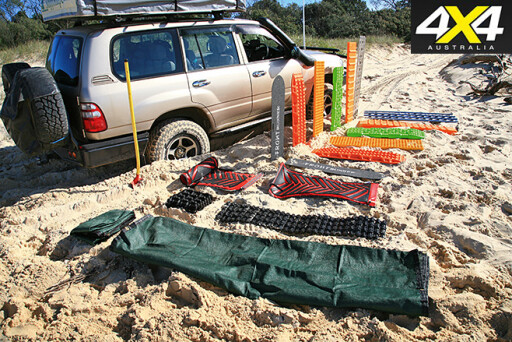 One point we noted was that most devices needed the board or matt to be placed at least partially under the tyres to enable the initial recovery process. The better designs with leading-edge ramps and increased grip via protruding lugs allowed the tyre to grip and ‘suck’ the board under it, helping the 4x4 to drive forward and lift out of the bog.
One point we noted was that most devices needed the board or matt to be placed at least partially under the tyres to enable the initial recovery process. The better designs with leading-edge ramps and increased grip via protruding lugs allowed the tyre to grip and ‘suck’ the board under it, helping the 4x4 to drive forward and lift out of the bog.
So, before we divulge the results of the traction-aid comparison, here’s all you need to know about each piece of recovery gear that we put to the test.
BUSHRANGER X-TRAX
 The Bushranger X-Trax (Series II) measure 1400mm long by 300mm wide per track and are sold in pairs, with each wrapped in a sturdy PVC carry bag. A pair weighs 16.4kg.
The Bushranger X-Trax (Series II) measure 1400mm long by 300mm wide per track and are sold in pairs, with each wrapped in a sturdy PVC carry bag. A pair weighs 16.4kg.
The X-Trax are a cast rubber compound, bound together via a length of galvanised steel cable, which allows the whole track to flex under the weight of the wheel and conform to the shape of the ground. Each small rubber section is shaped to interlock into the next and forms a series of ridges and valleys to provide a good rippled surface to drive on. This interlocking pattern somewhat helps to resist the ‘bunching up’ of the tracks while powering over them.
Being flexible, they can’t be used as a bridging ladder or a ramp unless you do some packing under the product, but they could be rolled and shoved into a hole to drive over.
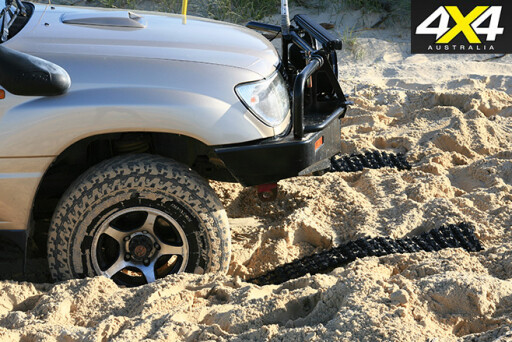 Given the compact size of the X-Trax, they could easily be stowed in the cargo area of any 4x4 or in the tool box of any camper trailer.
Given the compact size of the X-Trax, they could easily be stowed in the cargo area of any 4x4 or in the tool box of any camper trailer.
RRP is $198 per pair and they come with a decent five-year warranty.
Would I use them as a camping mat for the tent or an impromptu seat? Nope. They are a bit harsh on bare feet, unless you’re as tough as nails or regularly walk over coals or glass for fun.
For more information: www.bushranger.com.au
MAXTRAX MKII
 Unique in their shape, each UV-stabilised, semi-flexible, reinforced-nylon MAXTRAX has six (three on each side) handles. These come in handy when carrying the device and when using the tapered ends as a shovel. The ramped ends allow for an easier drive up for the stranded vehicle.
Unique in their shape, each UV-stabilised, semi-flexible, reinforced-nylon MAXTRAX has six (three on each side) handles. These come in handy when carrying the device and when using the tapered ends as a shovel. The ramped ends allow for an easier drive up for the stranded vehicle.
MAXTRAX measure 1150mm long by 330mm wide and weigh in at 7.2kg per set of two. Being easily stackable, one track measures 7cm high, while two are just 8.5cm high and four are only 11.5cm in height.
MAXTRAX are up to their second generation of product and it’s this latest release that incorporates a linking system to join the tracks end-on-end, with improved ribbing making them more robust. There is also a roof-rack mounting kit and a leash to tie to the ends of the tracks. A stack of colours are available to choose from, although bright orange is their ‘signature’ colour.
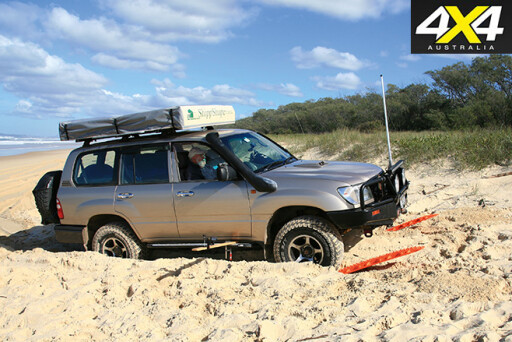 Being a long, non-rollable board, you’ll have to consider whether they will fit in or outside your vehicle, but mounting kits and carry bags are available. MAXTRAX are not recommended for use as bridges or ramps.
Being a long, non-rollable board, you’ll have to consider whether they will fit in or outside your vehicle, but mounting kits and carry bags are available. MAXTRAX are not recommended for use as bridges or ramps.
Would I use them as a camping mat for the tent or an impromptu seat? Not on your life, though we did gently try sitting on one after one recovery session and, yes, the 88 little teeth do make you grimace!
RRP is $299 per pair of MAXTRAX and they have a 12-month warranty.
The linking kit is $24.99 and the vehicle-mounting kit is $26.99.
For more information: www.maxtrax.com.au
TRED
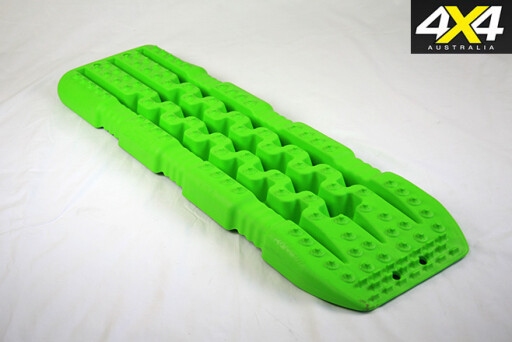 Incorporating hex-shaped grip nodules along their length, plus aggressive teeth on the ramp area, the TREDs can be used as a shovel at one end. And, while there are no dedicated handholds along the edges, most people would be able to hold the boards’ deep ribbed sides. TRED boards are manufactured from a blend of polyolefin materials and offer slight flexing to help maintain tyre contact during recovery.
Incorporating hex-shaped grip nodules along their length, plus aggressive teeth on the ramp area, the TREDs can be used as a shovel at one end. And, while there are no dedicated handholds along the edges, most people would be able to hold the boards’ deep ribbed sides. TRED boards are manufactured from a blend of polyolefin materials and offer slight flexing to help maintain tyre contact during recovery.
There are two sizes: a longer version measures in at 1080mm long by 317mm wide (the size we used) and weighs 3.074kg, with a RRP of $229. The shorter version is 790mm long and 268mm wide and weighs 2.16kg, at a RRP of $179. It’s great for those that can’t quite fit the larger version into or on their vehicles. Both versions are 73mm high and measure 105mm when two-stacked.
Being a non-flexible board, you’ll have to find a suitable place to carry them, but they do offer mounting kits, leashes and carry bags.
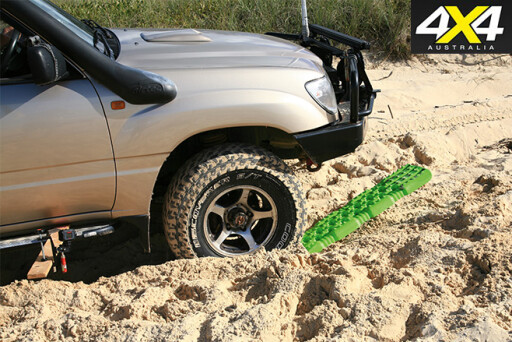 Available in nine colours, you’ll surely find one that matches your duco, or your favourite hue. TRED offers a lifetime warranty and are recommended for use on vehicles weighing up to 3.5 tonnes, but they are not recommended for use as bridges or ramps.
Available in nine colours, you’ll surely find one that matches your duco, or your favourite hue. TRED offers a lifetime warranty and are recommended for use on vehicles weighing up to 3.5 tonnes, but they are not recommended for use as bridges or ramps.
Would I use them as a camping mat for the tent or as an impromptu seat? Not on your life, but I did try hanging my ring spanners off all those little hex-shaped nodules.
For more information: www.Tred4x4.com
LIFTTRAX
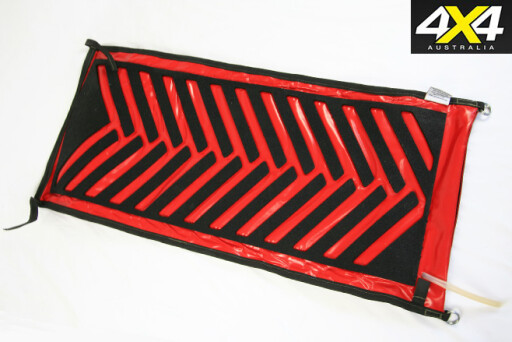 As the name suggests, the LiftTrax (or PillowTracks as they used to be known) are giant heavy-duty pillows that have the ability to carry the weight of a fully-laden 4x4 of up to 4000kg in weight. The LiftTrax measure in at 1020mm long by 490mm wide and are up to 40cm high when inflated. They can be interconnected end-to-end and the outer sleeve is of a high-strength non-tear material with a high friction surface. The replaceable inner bladder is an air-tight, pinch-resistant membrane.
As the name suggests, the LiftTrax (or PillowTracks as they used to be known) are giant heavy-duty pillows that have the ability to carry the weight of a fully-laden 4x4 of up to 4000kg in weight. The LiftTrax measure in at 1020mm long by 490mm wide and are up to 40cm high when inflated. They can be interconnected end-to-end and the outer sleeve is of a high-strength non-tear material with a high friction surface. The replaceable inner bladder is an air-tight, pinch-resistant membrane.
The LiftTrax work effectively over a pressure range of 1-10psi and can be used as a track in soft surfaces (like sand), as a bridging ladder between rocks, or as a ramp to help climb rocks. If you’re bellied out on a rock or sand dune, they can act as a (limited) jack to lift a 4x4 straight up. You can do this by placing the LiftTrax under the front or rear wheels before inflating the devices to (hopefully) free the stuck vehicle.
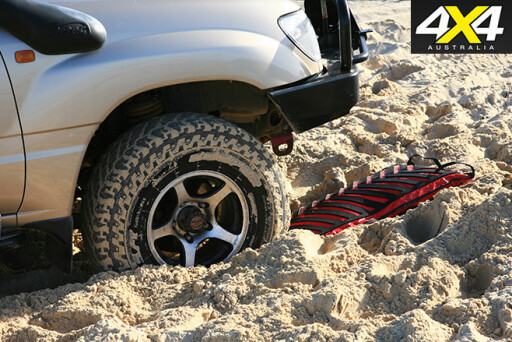 The bags can be inflated with an air compressor (the kit comes with an adaptor for this and you’d have to use this method to lift a vehicle). To inflate them at other times you can use your lungs… hopefully you’re not out of breath from all that shovelling!
The bags can be inflated with an air compressor (the kit comes with an adaptor for this and you’d have to use this method to lift a vehicle). To inflate them at other times you can use your lungs… hopefully you’re not out of breath from all that shovelling!
In their deflated state they can be conveniently rolled and stored in their own carry bag and weigh 8kg per pair.

RRP is $349, which includes the carry case and shipping costs.
For more information: www.lifttrax.com.au
FRONT RUNNER TRACTION MATS
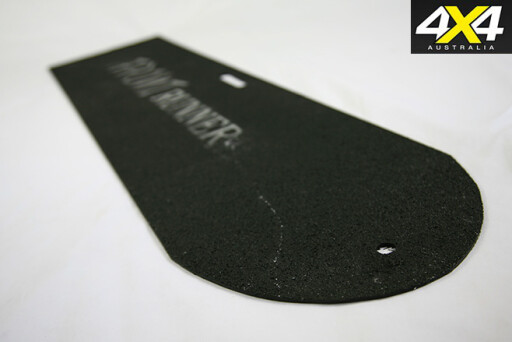 Front Runner traction mats are a fibreglass composite board with a high-traction, non-slip surface on the top face and a smooth surface underneath. They are 6mm thick and stack flat on top of each other. Measuring 1150mm long by 260mm wide, you’ll need to be sure where you can store them in your vehicle or on the roof racks, but given that they’re only 6mm thick each, they stack quite compactly. With a pair weighing in at only 5.2kg, the Sand Lizards are one of the lightest tracks around.
Front Runner traction mats are a fibreglass composite board with a high-traction, non-slip surface on the top face and a smooth surface underneath. They are 6mm thick and stack flat on top of each other. Measuring 1150mm long by 260mm wide, you’ll need to be sure where you can store them in your vehicle or on the roof racks, but given that they’re only 6mm thick each, they stack quite compactly. With a pair weighing in at only 5.2kg, the Sand Lizards are one of the lightest tracks around.
The Front Runner mats are best used on soft surfaces like sand, mud and snow and will not double as bridging ladders or ramps unless packed with support underneath. Each mat is quite flexible and has a handle cut into one side. There’s also a hole at one end for attaching a lanyard to help recover each track after a recovery.
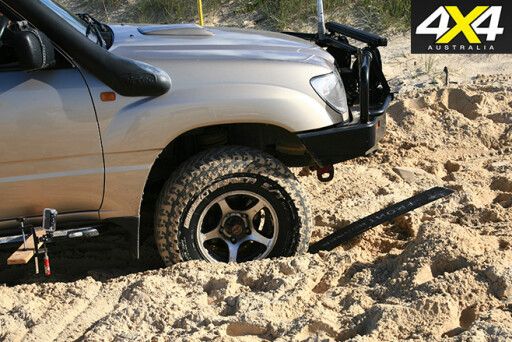 Would I use them as a camping mat for the tent or an impromptu seat? Ummm…a bit rough to stand on for me, but tougher soles could do so. The abrasive surface would chaff you if used as a seat – but then again, if they’re turned upside down, the nice smooth finish solves your problems!
Would I use them as a camping mat for the tent or an impromptu seat? Ummm…a bit rough to stand on for me, but tougher soles could do so. The abrasive surface would chaff you if used as a seat – but then again, if they’re turned upside down, the nice smooth finish solves your problems!
RRP is $220 plus shipping (imported).
For more information: www.frontrunner.co.za
SAND TRAX TRACTION MAT
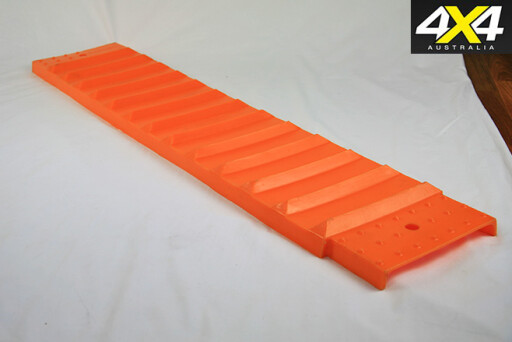 The Sand Trax are roto-moulded poly tracks that measure 1400mm long by 280mm wide by 40mm high, and are stackable. Each track can be linked via a single hole in each end.
The Sand Trax are roto-moulded poly tracks that measure 1400mm long by 280mm wide by 40mm high, and are stackable. Each track can be linked via a single hole in each end.
Being the second longest semi-rigid tracks available, they are pretty much a roof-rack option only – unless you have the room to store them in a Troop Carrier, a Defender or the likes.
The tracks are best used on soft surfaces including sand, mud and snow, and will not double as bridging ladders or ramps unless time is spent packing support underneath them. They are semi-flexible and weigh in at 3kg per track.
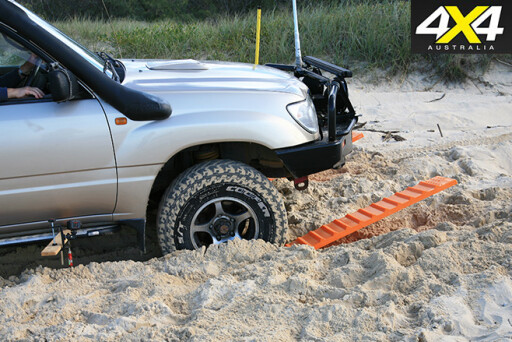 When using these ramps, as you slowly drive, the stuck vehicle tends to pull the tracks underneath. The vehicle will ‘lift up’ out of the bog as well as forward. With the ‘corrugations’ in the lateral position only, there is little grip across the boards.
When using these ramps, as you slowly drive, the stuck vehicle tends to pull the tracks underneath. The vehicle will ‘lift up’ out of the bog as well as forward. With the ‘corrugations’ in the lateral position only, there is little grip across the boards.
Would I use them as a camping mat for the tent or an impromptu seat? Nup, too rough and irregular for me.
RRP is $150 per pair and they have a 12-month warranty.
For more information: www.dolium.com.au
MUPUTRAX
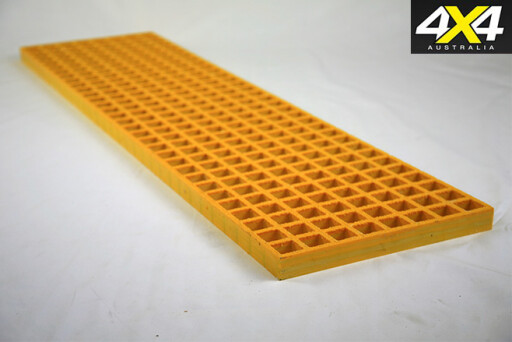 Muputrax are made of a 32mm-square-holed grate that originates from the FRP industrial grating industry. The top surface is impregnated with a hard-wearing quartz grit to enhance traction and grip. It’s also non-corrosive, non-slip, UV-stabilised and fire retardant. The larger tracks measure 123cm long by 31cm wide by 3cm thick and weigh 5.9kg per track, while the shorter versions are 84cm long by 31cm wide by 3cm thick and weigh 4.3kg per track. Because the product has so many square holes, the user can easily attach a lanyard to help recover it from a bog hole.
Muputrax are made of a 32mm-square-holed grate that originates from the FRP industrial grating industry. The top surface is impregnated with a hard-wearing quartz grit to enhance traction and grip. It’s also non-corrosive, non-slip, UV-stabilised and fire retardant. The larger tracks measure 123cm long by 31cm wide by 3cm thick and weigh 5.9kg per track, while the shorter versions are 84cm long by 31cm wide by 3cm thick and weigh 4.3kg per track. Because the product has so many square holes, the user can easily attach a lanyard to help recover it from a bog hole.
The Muputrax can be used in most off-road situations as a traction board on soft ground (sand, mud and snow), but they can also be used as a bridging ladder or ramp to bridge over difficult terrain, to help your vehicle climb rocks and steep slopes and to aid in tackling washouts. When put to the test as ramps and bridges, they deflected a lot under the weight of our Land Cruiser, but they returned to their original shape without damage once the Cruiser was removed.
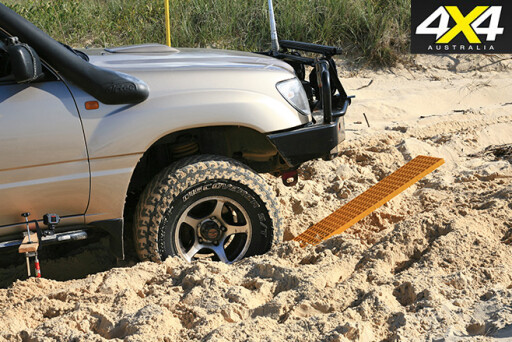 Each Muputrax is rated to carry a load of 5000kg as a sand ladder and 1500kg as a temporary bridge. Would I use them as camping mats or seats. No. They’re too rough for my wimpy feet.
Each Muputrax is rated to carry a load of 5000kg as a sand ladder and 1500kg as a temporary bridge. Would I use them as camping mats or seats. No. They’re too rough for my wimpy feet.
RRP is $250 (plus delivery) for the larger set including leg kit, and $225 (plus delivery) for the smaller set including leg kit. Both have a three-year warranty.
For more information: www.muputrax.com.au
HOMEMADE
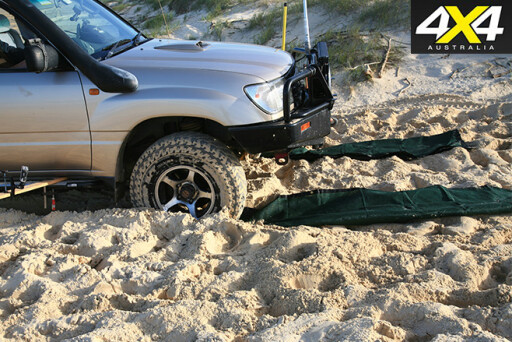 There will always be the option of making your own traction boards or mats using materials like carpet, Weldmesh, shade cloth, cut-up milk crates or anything equivalent. We’ve opted to use a length of shade cloth as it should be easier than carpet to clean and dry, is easily stored, is lightweight… and … plenty of soles claim it works, so we wanted to see for ourselves.
There will always be the option of making your own traction boards or mats using materials like carpet, Weldmesh, shade cloth, cut-up milk crates or anything equivalent. We’ve opted to use a length of shade cloth as it should be easier than carpet to clean and dry, is easily stored, is lightweight… and … plenty of soles claim it works, so we wanted to see for ourselves.
There are no specific specs for it; I used two pieces folded up to about half a metre wide by two metres long… because that’s what I had in my shed. Of course, you could easily use longer lengths to help in long sections of soft sand and the like.
As for sitting on these homemade options; you betcha, I would. Plus, they cast a beaut shade at lunch time, can be used under your swag or tent and they make great picnic rugs for a smoko.
ALUMINIUM BRIDGING LADDERS: SAND LADDER
 Remember the old Camel Trophy days? You know, when real men (supposedly) smoked Camel ciggies, drove Land Rover Defenders and carried huge metal bridging ladders on the sides of their 4x4s. Well, some things haven’t changed (like real men driving Land Rovers… let the debates begin ehh!), but those old-style ladders aren’t readily accessible in Australia and have been replaced by lighter and better-designed versions.
Remember the old Camel Trophy days? You know, when real men (supposedly) smoked Camel ciggies, drove Land Rover Defenders and carried huge metal bridging ladders on the sides of their 4x4s. Well, some things haven’t changed (like real men driving Land Rovers… let the debates begin ehh!), but those old-style ladders aren’t readily accessible in Australia and have been replaced by lighter and better-designed versions.
Yours truly was unfortunate enough to have to use a substandard, thin, aluminium set in the 2010 Dakar Rally while bogged to the knees in mud. Unfortunately for us, they bent like bananas under the weight of the 4x4, couldn’t be straightened and also couldn’t be stored back where they came from in the vehicle, because of the bending. The semi-smoothed surface tracks, combined with mud, ended up just too slippery to be of much use, which shows how vital it is for the upper surface to have as much grip as possible.
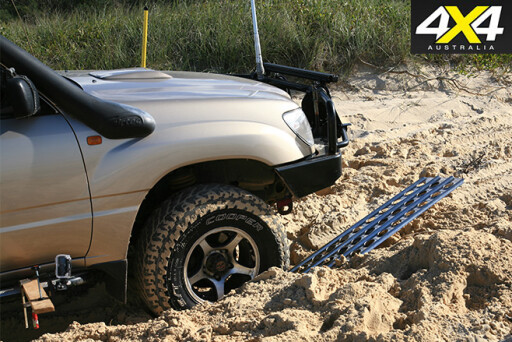 The ladders we used would never have taken the weight of our 4x4 due to their inherent weakness but, from watching the use of higher-quality equivalents, I can attest to their strength for use in bridging and ramping.
The ladders we used would never have taken the weight of our 4x4 due to their inherent weakness but, from watching the use of higher-quality equivalents, I can attest to their strength for use in bridging and ramping.
We purchased and imported a superior set, which offers a range of sizes (125cm, 150cm, 175cm and 200cm long by 44cm wide), plus the option of reinforcing the underside as per the 150cm set we used. The alloy Sand Ladders offer plenty of strength to carry our Land Cruiser during bridging and would be at home on most long distance tourers. The alloy will (or should) never wear out, so it will last a lifetime. I guess the only downside to that is perhaps they might damage your tyres more during wheel spin compared to the sacrificial qualities of the plastic versions.
For more information: www.sandladder.net
SAFETY FIRST
For safety’s sake, no, we shouldn’t drive alone in remote areas – bush or beach – but, in reality, solo driving is sometimes going to happen. That’s the reality of 4x4ing; we get out and about to be away from the crowds for a bit of adventure, serenity and downtime.
Unfortunately, that’s when things tend to go wrong – when there’s no one around for miles or days to help you out of the pickle you’ve gotten yourself into.
So, for your own safety, be sure to use a bucket of common sense, mixed with a shovel load of good judgement, blended with as much realistic discretion about the use of these ‘get yourself outta jail’ devices.
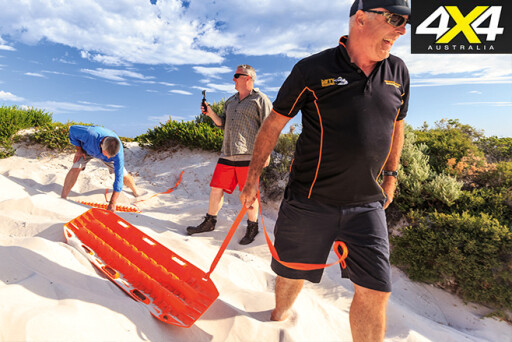 THE RESULTS
THE RESULTS
The Muputrax: This recovery device offers great versatility. It can be used as a recovery track, a bridging ladder, a jacking base plate and a ramp. The standard leg kit means it can even be used as a table, chair, doormat, clothesline or walkway – if you believe the more gimmicky aspects of the company’s advertising.
Unfortunately, in the sand, the Muputrax didn’t perform too well. The small squares filled with sand (this added considerable weight) and the ‘drag’ on the sand didn’t allow the whole board to slide under the 4x4. We tried several times, but the lack of grip made for one of the hardest recoveries of the day.
The units were heavy and didn’t have wedge-shaped leading edges, so they weren’t ideal for sand recovery. They’d be best kept for bridging, ramps or to be used as a clothesline with the included kit. With our constant recovery attempts (yep, with dreaded wheel spin), we did grind away the abrasive top surface, as well as slightly wear down the fibreglass board.
The Sand Ladder (imported): It certainly lends itself to being multi-use as it’s plenty strong enough to double as a bridging ladder, ramp and jacking base. It’s longer than all the others, so that’s also a big plus… until it comes time to pack it away.
It doesn’t deliver the same initial grip on its leading edge, or overall surface, with its smoother texture and perforated pattern not allowing anywhere near the traction of some others.
 The price is pretty high with the importing costs added on, but if you really want the ‘look’ of the old-time ladders, then these would be your pick.
The price is pretty high with the importing costs added on, but if you really want the ‘look’ of the old-time ladders, then these would be your pick.
Provided you don’t bend them, these aluminium boards should never wear out, making them perhaps a good long-term investment, depending on your needs. Then again, because they don’t wear out during accidental wheel spin, they might cause damage to your tyres!
The LiftTrax: They are fiddly because you have to inflate and deflate them for simple recoveries, but an advantage is their ability to act somewhat like an exhaust jack to slightly lift a vehicle to help fill a hole. The available vertical-lift height, however, is nowhere near high enough when compared to a dedicated exhaust jack, so it’s relatively useless in real life.
While not strictly useable as a ramp, the LiftTrax can be used to ‘fill’ a hole to allow your 4x4 to drive over. While the inner bladders are said to be ‘heavy duty’ and replaceable, I’d still be worried about punctures at the most inopportune times.
During our use, they also tended to roll out of position just as the Cruiser mounted them. We tried a few different inflation pressures, with the best results being at quite low inflation… almost negating the ‘inflatable’ virtues. We did damage the rubbery grips slightly and found the bags lacking in overall performance. They do, however, provide a great spot to sit on at lunch time!
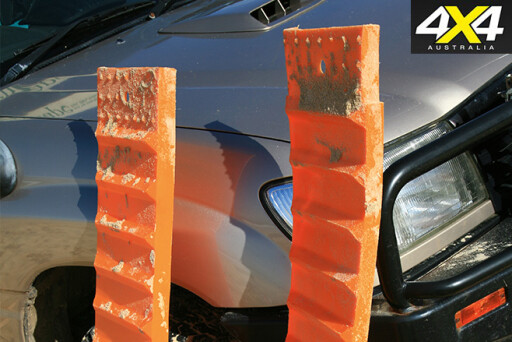 The Sand Tracks: These offer good longitudinal grip, but little lateral grip. They did, however, work well in our tests, allowing the tyre to grip and slide under the 4x4. A lack of rigidity was evident, with one use of the product resulting in bends in both boards. But they did return to shape to allow further use. Watching our video carefully, you’ll see the boards suck under the tyre, bend in half and eject rearwards.
The Sand Tracks: These offer good longitudinal grip, but little lateral grip. They did, however, work well in our tests, allowing the tyre to grip and slide under the 4x4. A lack of rigidity was evident, with one use of the product resulting in bends in both boards. But they did return to shape to allow further use. Watching our video carefully, you’ll see the boards suck under the tyre, bend in half and eject rearwards.
Front Runner: These flexible fibreglass boards returned reasonable grip, but the sad fact was that we snapped one board in half on the second (failed) attempt.
Initially, both boards gripped and spat out the rear of the tyres only to be flexed and jammed under the Cruiser, which didn’t move too far forwards and remained bogged. After extracting the boards and giving them a second shot, we snapped one board clean in half, rendering it useless.
The Bushranger X-Trax: In theory, they should have helped to extract the bogged Cruiser, but in reality, they did little due to a lack of rigidity. Sure they gripped well, but only to eject rear of the tyre with little forward movement. After plenty of attempts, we resigned to using another board to get ourselves unstuck from the bog.
 MAXTRAX and TRED (We’ve combined comments for these two products): When used in softer driving situations like sand, mud and snow, the semi-stiff boards of these products wedge under your tyres. Your stuck vehicle tends to pull the boards underneath as you slowly drive, lifting the vehicle up, forward and out of the bog.
MAXTRAX and TRED (We’ve combined comments for these two products): When used in softer driving situations like sand, mud and snow, the semi-stiff boards of these products wedge under your tyres. Your stuck vehicle tends to pull the boards underneath as you slowly drive, lifting the vehicle up, forward and out of the bog.
MAXTRAX and TRED boards quickly became our back-up devices when one of the others didn’t work. Given that, they got more of a workout in situations that were much harder than the testing standards, so I’ll give both boards full marks for their extracting abilities.
It’s a close call between the two, but I reckon MAXTRAX takes out top honours, given the product’s in-built design features: the handles down both sides of the boards make for easier shovelling, the overall shape was easier to handle and because the MAXTRAX have ramps at both ends (compared to the TREDs, which have them at just one end) their service life is effectively doubled as the high-grip nodules eventually wear down. Plus, as an added benefit, they come standard with a leash to help find and remove the boards from bogging. They also supply components that hook sets together to form a longer track, roof-rack mounting kits, a spare wheel-mounting harness and carry bags.
The MAXTRAX product was the best self-recovery device, outperforming all the others on the day. Its only downside is its lack of bridging ability. If I were in a pickle, however, I would just stack a couple on top of each other for added strength. MAXTRAX are renowned worldwide, are Aussie designed and made, and would be a compliment to any recovery kit.
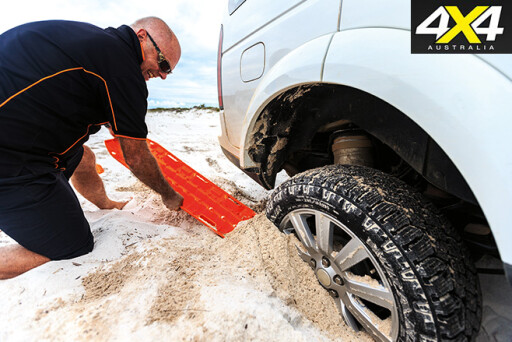 Oh, don’t forget my homemade set of Shade Cloth Recovery Eventual Anti-bog Mats (I called them SCREAM for short, because that’s generally what happens when you can’t get yourself unstuck with them).
Oh, don’t forget my homemade set of Shade Cloth Recovery Eventual Anti-bog Mats (I called them SCREAM for short, because that’s generally what happens when you can’t get yourself unstuck with them).
They didn’t work one little bit. They just sucked under the wheels, bunched up into one huge mess and spat out the rear, full of sand. The biggest advantage of my SCREAMs is the shade they cast when sitting down for lunch.
Regardless of which device you choose, one important part of any recovery kit should be a shovel. Sure, some boards in our test can double as a shovel, but using the right tool for the job makes life easier.
Happy 4x4ing, happy self-recoveries and most of all, stay safe and take your time when extracting your 4x4 from any sort of bogging.
Remember, we’ve filmed the whole Recovery boards 4x4 beach test; there’s some beaut footage showing exactly how each product works.

COMMENTS